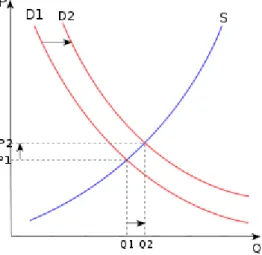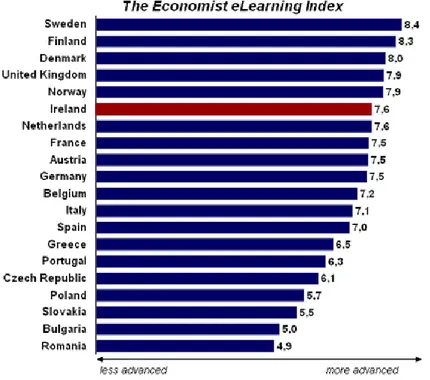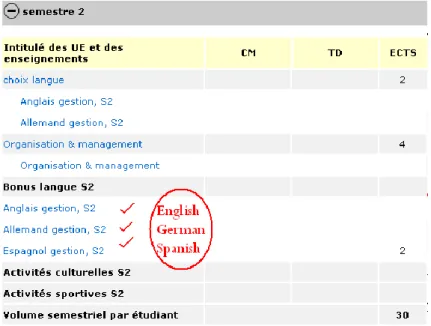HAL Id: hal-00448622
https://hal.archives-ouvertes.fr/hal-00448622
Submitted on 19 Jan 2010
HAL is a multi-disciplinary open access
archive for the deposit and dissemination of
sci-entific research documents, whether they are
pub-lished or not. The documents may come from
teaching and research institutions in France or
abroad, or from public or private research centers.
L’archive ouverte pluridisciplinaire HAL, est
destinée au dépôt et à la diffusion de documents
scientifiques de niveau recherche, publiés ou non,
émanant des établissements d’enseignement et de
recherche français ou étrangers, des laboratoires
publics ou privés.
E-Learning consequences of the declining interest in
engineering studies in Europe
Luz-Marcela Morales, Katherine Maillet
To cite this version:
Luz-Marcela Morales, Katherine Maillet. E-Learning consequences of the declining interest in
engi-neering studies in Europe. E-Learn ’09 : World Conference on E-Learning in Corporate, Government,
Healthcare, & Higher Education, Oct 2009, Vancouver, Canada. pp.3380-3386. �hal-00448622�
E-Learning Consequences of the Declining Interest in Engineering Studies
in Europe
Marcela Porta, Katherine Maillet Institut Telecom SudParis, Evry, France {marcela.morales, katherine.maillet}@it-sudparis.eu
Abstract
The success of e-learning in a specific country is based on the number of computer science experts involved in the same geographic area. As a fact, the entire development of an e-learning infrastructure depends on the persons who have the expertise to create and maintain e-materials.
Unfortunately, in 2006 official European statistics on education (see Eurostat 2007) showed that the interest in computer science and engineering fields of study had decreased each year, attesting to a decline in interest among K12 students for these careers, thus potentially affecting e-learning progress.
This paper aims to illustrate the importance of the declining number of engineering experts in Europe and the possible consequences in the e-learning field if this decline persists. It will also identify similar consequences which have already occurred in other industrialised countries such as Canada and United States (see Computer Research Policy 2007).
Keywords: E-learning methods; Engineering school; attracting human talent to computing
1. Introduction
In 2006 European statistics showed that a total of 18.8 million students graduated from tertiary education in Europe, from which 1.86 million chose computer science and engineering domains, representing 9.9% of the total (see Eurostat 2007).
In order to determine the significance of these results, it is important to make a comparison with other careers. This analysis will make it possible to generate conclusions and answers to some relevant questions such as:
What are the consequences of the declining number of engineering experts in industry and research?
More important, how will all the changes produced by this decrease affect e-learning in the countries that are making more use of it.
To obtain answers to these questions this document is divided in four parts:
Section two will provide a summary of the previous work and reports related to the research of this problem. . Section three will present official statistics and highlight trends in the number of engineering students in Europe. It will also provide comparisons between different domains of study.
Section four will list the possible consequences on e-learning that a reduction in the number of engineering students might produce. However, not all these consequences are negative; some of them will enhance e-learning research in to face social changes.
Finally, section five presents the conclusions of the study and recommends future investigations to attract and retain people to this domain of study.
A certain number of studies that tackle the problem of attracting talent to engineering in general and the large number of works which target strategies to attract women to computer science e.g. (Madison, S. and AL 2008 and Mahar, J. 2008), will make it possible to get some ideas about how to attract and retain people to this field of study.
Some other initiatives focus strategies on a more specific area; they create teaching and learning methods to enhance e-learning and support students with the help of information technologies such as Effective video clips
for Web-based language learning (Kobayashi, T. and AL 2008).
In fact, the development of such strategies permitted to attract undergraduate students historically not enrolled in computing courses (Madison, S. and AL. 2008). However, it is more difficult to understand the possible consequences to the future of engineering and more specifically to e-learning research and deployment if these strategies and methodologies are not developed.
3. Population results and education key statistics in Europe – 2006
The point of departure for this work is official key European statistics published by Eurostat (see Eurostat 2007). This organisation publishes certified statistics which reflect the economic and social situation in European countries. Eurostat provides information about education, including a breakdown of the data for each field of study, like engineering and computer science. This analysis makes it possible to understand the general performance of computer science schools in Europe, thus providing some conclusions about the importance of the downward trend in this field and the consequences in e-learning.
3.1 Overview of statistics in Europe 2000 - 2006
The population and social conditions given by Eurostat (see Eurostat 2007) reflected an increasing number of students entering high tertiary education. As shown in Figure 1, this number (always lower than K12) is increasing in a continuous way.
Figure 1: Number of pupils and students by level of education (in millions), EU27, 2000 to 2006
Unfortunately this increase does not concern every field of study. Other Eurostat analysis reflected a decline in some fields of study, more especially computer science; see Figure 2 (see Eurostat 2007).
Figure 2: Distribution of tertiary graduates by field of education, EU27, 2000 and 2006, in %
This graph illustrates how the number of students in computer science and engineering has decreased each year as compared to other fields of study. By analysing this reality it is important to highlight two main anomalies: a) While most careers are on the rise or remain stable, careers related to computer science, which are considered to be the most promising and innovative ones, are decreasing. In the United States, few people doubt that technological skills will become increasingly important as we enter the 21st century (Madison, S. and AL 2008). b) The negative results for technology studies in developed countries in Europe are surprising where an important part of their industries depend on the evolution of technology.
There are other analyses that reflect and confirm this information, but the most important one is represented in Figure 3, provided by the Computer Research Policy Association (Computer Research Policy 2007). It shows the global decrease of engineering and computer science since 1971.
3.2 Analysis of the situation
The statistics illustrated above indicate a downward trend in the number of persons studying engineering and computer science which will result in a decrease in the number of native computer scientists in the future. This trend will also impact careers in fields related to information technologies such as e-learning.
The next section presents the possible consequences of a decline in computer science on e-learning and supports these predictions with results from official reports and examples.
4. Possible impacts in e-learning caused by the reduction of computer science experts
This section lists and analyzes the possible consequences resulting from a declining activity in computer science and expert engineers needed for e-learning.
4.1 The increasing price of e-learning development:
In general, when the number of experts needed for a sector of industry is reduced it results an increase in price of the goods or services provided by that industry. The economic model of supply and demand elasticity illustrates the relationship between the numbers in the labour force and the market price. A decreased labour force confronted with a constant level in demand causes a price increment (Henderson and Hubert D. 1952).This theory is briefly illustrated in Figure 4.
The price P of a product is determined by a balance between production at each price (Offer) and the desires of those with purchasing power at each price (demand).
Figure 4: Economic model on supply and demand elasticity.
The price of the development and deployment of e-learning depends on the number of computer science experts. If the number of experts is reduced in a country, an alteration in the price of e-learning development should be expected.
The increase in the price of computer and engineering development and the decrease in the number of professionals in the industry can be related to the initiative of the companies that migrate their labour forces to foreign countries like India, where development work is as effective as in Europe, there is a larger labour force with a greater capacity of production, and the cost is less expensive. On July 15th, 2009, the Harvard Business review published an article in the New York Times: “Study Plays Down Export of Computer Jobs” (Lohr 2006). This article explains this migration phenomenon and highlights the very concerning consequences of it with phrases like:
“The study concluded that dire predictions of job losses from shifting high-technology work to low-wage nations with strong education systems, like India and China, were greatly exaggerated.”
“The concern is that misplaced pessimism will deter bright young people from pursuing careers in computing. That, in turn, would erode the skills in a field that is crucial to the nation's economic competitiveness”.
P = price S = offer D = demand Q = quantity
In addition, as illustrated in Figure 5, the emerging countries that produce technology are not the strong investors of e-learning (e-User, Public Online Services and User Orientation, Ireland: Economist eLearning Index, 2009), causing stagnation in e-learning research. Explained from this perspective, the number of students and experts in the technological field is crucial to balance prices and promote the e-learning progress.
Figure 5: Economist eLearning Index
4.2 Increase in careers other than computer science and engineering
It is important to consider the increase in careers other than computer science. As shown above, careers in business and social sciences are currently increasing the most (Eurostat 2007). This growth takes students away from engineering as a field of study as they are attracted, more and more, to business and management courses. This trend results in a high proportion of managers and businessmen and a low number of engineers and technology professionals. The global increase in demand of technology, the declining interest in technology careers in Europe coupled with increased interest in international commerce and purchasing means that the technology that is not developed in Europe will be purchased from other countries. As a result e-learning will be affected as a sub-set of the technology that has to be purchased from other countries.
However, there is another impact that will affect e-learning in a direct way. In order to take advantage of this situation, e-learning must be adapted and expanded to help management and business students to understand related issues, such as the learning of foreign languages and cultures. This point is illustrated in the next section of this work.
4.3 The adoption of other cultures and languages
Considering the increased interest in international business and management careers, the importance of learning foreign languages and cultures is also increasing to prepare future professionals to succeed in negotiations with other countries, for example, those producing and trading technology.
Today, languages such as English, French, Spanish, the most widely languages in Europe and in the world, are losing their popularity to languages such as Chinese or Russian, because these languages are spoken in the countries producing and selling goods and services. As published in the national news paper of New York “Lessons in Mandarin Chinese-language immersion school nears reality in Eugene” (Williams 2009).
It is primordial to take into account languages and cultures when designing the curricula for careers in Europe. If European universities are willing to provide high standards and useful education, they must be prepared for these global changes and extend their development through the learning of other languages.
Unfortunately, if we take for example one of the most popular careers in one of the best universities in Europe (Figure 6), we can see that this kind of establishment is not yet providing their students with support for learning these languages such as Chinese or Russian.
Figure 6: II semester curricula of economy and management, university Sorbonne
Some studies have already demonstrated the importance of teaching languages at long distance (e-learning) and have shown good results of learning methods (Zimmermann 1986).
One of the reasons to use these e-learning methods to learn languages is that it promotes a learner’s autonomy in learning. Learners control themselves as degrees of meta-cognitive, motivation; behavioural engagements vary (Zimmermann 1986).
As a result of this analysis, we can conclude that the need to learn foreign languages and cultures could represent an opportunity for e-learning to introduce itself as an effective way of education. However, curricula designers must recognize the importance of this need.
5. Conclusions and future work
This study identified the impact that a decrease in the number of computer science students may have on e-learning. A declining number of computer science students means a reduced number of professionals in the future, and could produce an increase in the price of local technology and e-learning development and the migration of these industries to foreign countries. It may also slow down the development of e-learning, because these countries are not deploying e-learning or conducting research of this field.
The decline of computer science students is produced an increase in other careers such as business and management that are growing due to the need to negotiate technology with other countries. This phenomenon will also generate other trends such as the desire to learn the languages and cultures of the countries which develop technologies.
Further research is needed in order to identify the consequences of the declining interest in engineering studies in Europe, to discover the reasons that prevent people from choosing computer science as a field of study and to create strategies to attract and retain human talent to engineering and with this, cooperate with the development of e-learning.
6 References
[1] Eurostat: Official European Statistics. (2000 – 2006)
http://epp.eurostat.ec.europa.eu/cache/ITY_OFFPUB/KS-QA-08-042/EN/KS-QA-08-042-EN.PDF [2] Madison, S. and AL. (2008) Project Focal Point: Attracting females to the computing sciences. ACCE Elearn 2008.
[3] Mahar, J. (2008). Virtual Outreach through virtual worlds: a model for attracting and keeping women in
computing. ACCE Elearn .
[4] Kobayashi, T. and AL. (2008). Effective Video Clips for Web-based Language Learning. ACCE Elearn 2008.
[5] Computer Research Policy. Review from the annual results 2007 http://www.cra.org/govaffairs/blog/ [6] Henderson, Hubert D. (1946). Supply and demand: The theory of elasticity in price. Hancourt.
[7] Lohr, S. (2006). Study Plays Down Export of Computer Jobs. New York Times Harvard Business Review. [8] e-User, Public Online Services and User Orientation, Ireland: Economist eLearning Index, (2009)
http://www.euser-eu.org/euser_countrybrief.asp?CaseID=2055&CaseTitleID=742&MenuID= [9] Curricula report university of Sorbonne Paris 1. 2nd year Economy and Management, (2009)
http://www.univparis1.fr/ws/ws.php?_cmd=getFormation&_oid=UP1PROG8270&_redirect=voir_fiche_diplom e&_lang=fr-FR
[10] Zimmermann, B.J. (1986). Development of self-regulated learning: Which are the key sub-processes? Contemporary Educational Psychology, 16, 307 – 313
[11] Williams, A. (July 22, 2009). Lessons in Mandarin Chinese-language immersion school near reality in




